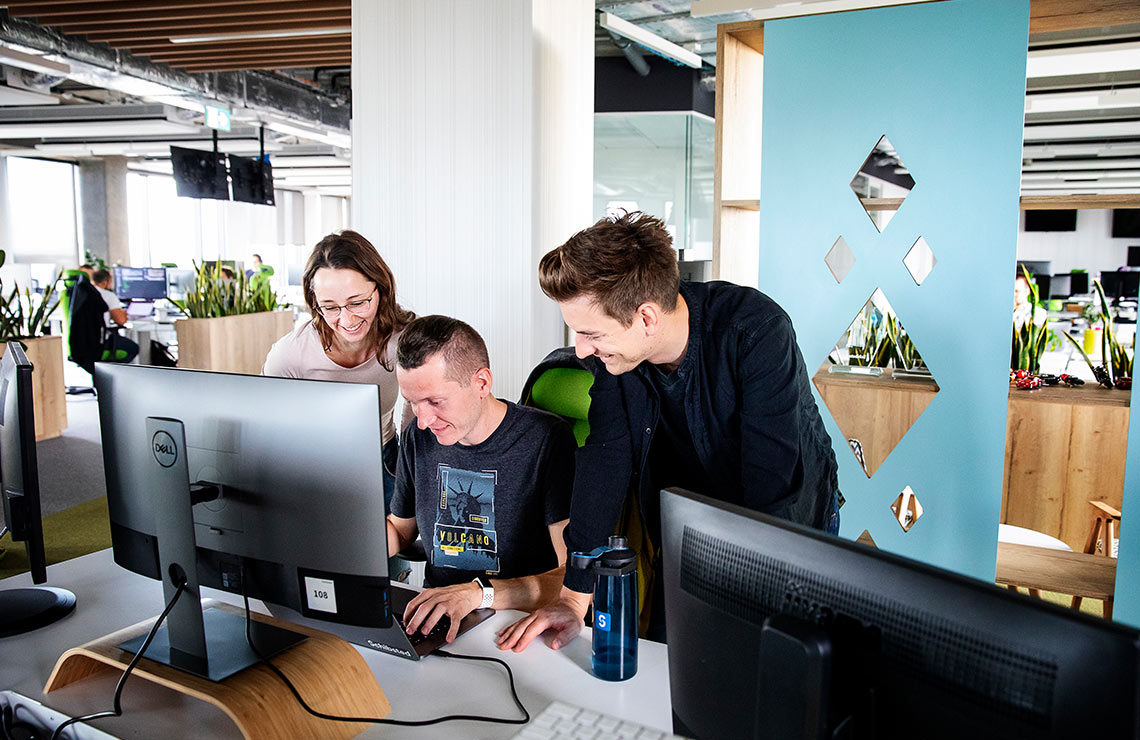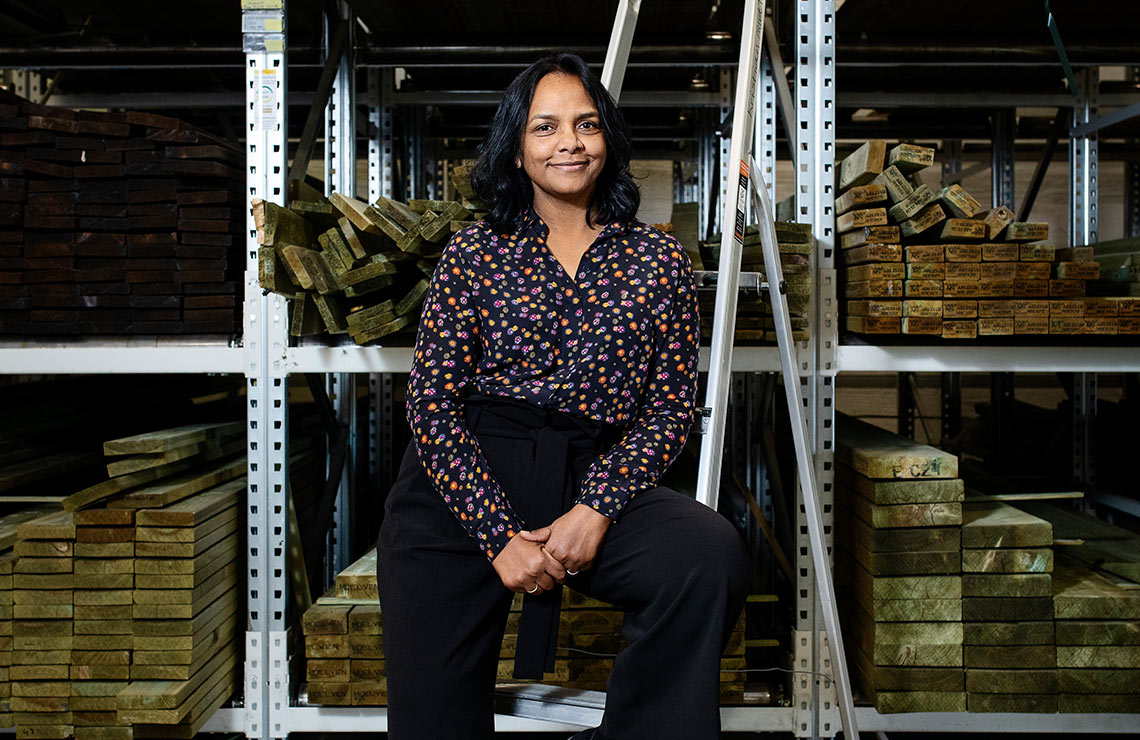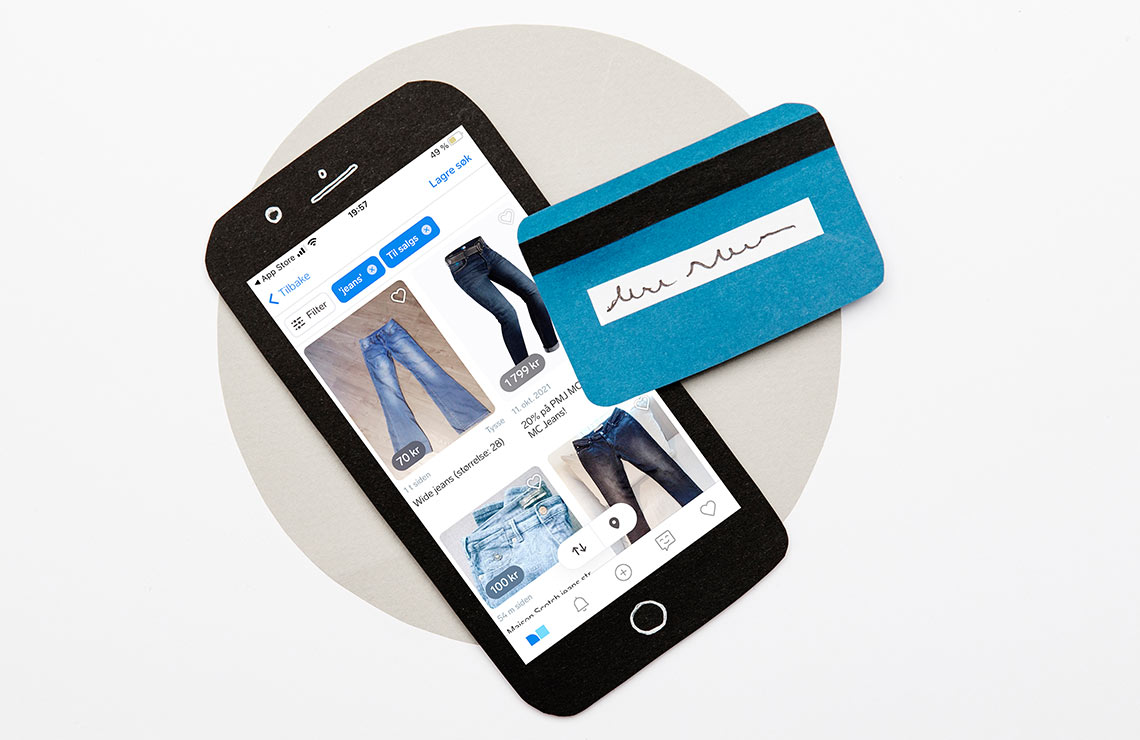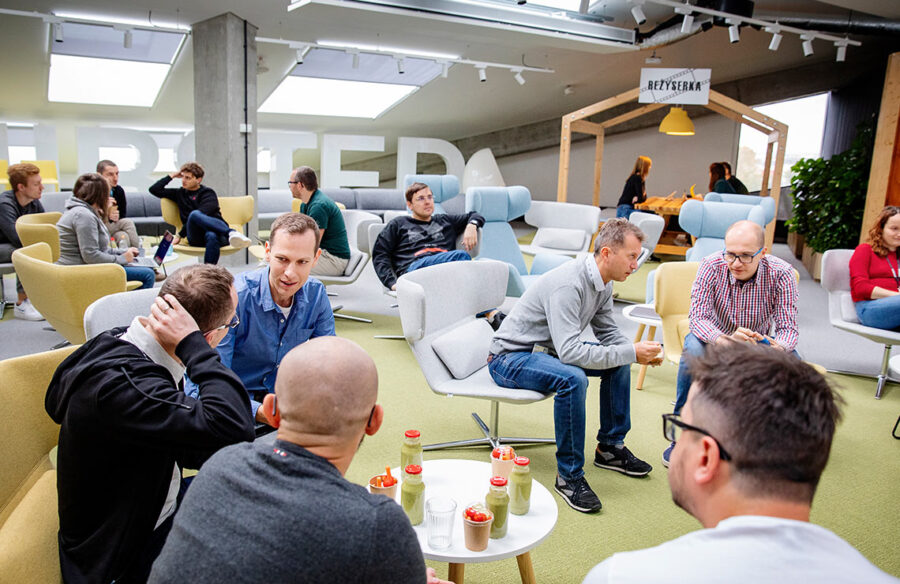A superposition to change computing

The quantum computers that exist today typically look like large chandeliers, hanging from the roofs of science labs.
A superposition to change computing
Is quantum computing the next major revolution in computer science or will it remain a dream scenario for the foreseeable future? Sven Størmer Thaulow, EVP Chief Data and Technology Officer, looks into an area that is still surrounded by myths.
The fields of quantum mechanics and quantum computing are difficult to understand, even for people who have studied them at university level. But what are they, and what makes their application in computer science so interesting?
First we need to take a step back. Data processing traditionally operates via a digital computer language; everything – images, sounds, text, etc – is broken down into 1s and 0s. When I write “S” using my keyboard, it represented as “01010011” – the ASCII character code in binary format. This is done by feeding current into eight “transistors” in a processor (or chip), with different voltage levels representing the binary states of “1” or “0”. A thing inside the computer reads this and displays “S” on my screen.
Packing transistors
In data processing, building more powerful computers has largely been a matter of packing as many transistors as possible into a chip and getting the clock frequency (the speed at which the computer computes) as high as possible. Many will be familiar with Moore’s Law describing the increase in processing power. It states that the number of transistors on a chip will double every other year. It’s hotly debated, but for some years now, many have claimed that Moore’s Law will soon be dead and that we have reached the limit for how many transistors can be packed into a chip. We’re currently down to three nanometres between the transistors, with the standard distance on your Iphone chip being five nanometres. Attempts to remedy this are being made by designing processors in 3D and other techniques.
However, increased computing power is not just about the number of transistors on a single chip; today we buy vast amounts of computing power in the cloud and no longer have to rely on having our own computers in-house. This means that we can all easily access vast resources to solve computing problems precisely when needed, no more, no less.
Machine learning behind the demand
Demand for such computing power has grown especially rapidly due to the need to train machine learning algorithms on large datasets. These algorithms try to find an optimum in a system with a large number of dimensions (for example, housing prices) – a big mathematical problem. Just imagine how many variables that influence the price of a house. The bigger and more complex the optimisation task, the greater the need for computing capacity – a need it will be difficult to keep up with using conventional data processing techniques. Even today, tasks already exist that are so complex that running them on even the world’s biggest computer cluster is inconceivable. This is where quantum computing is emerging as a promising technology.
Quantum computing is about using quantum mechanics – the theory of how things interact at small scale – to create a computer that is insanely faster at solving certain problems than a conventional binary computer. A quantum computer does not have bits (no 0s or 1s) but rather qubits, i.e. bits with more states than just 0 or 1. Qubits draw on two properties that distinguish them from regular bits: first, they can be put into a “superposition state” that represents both 1 and 0 simultaneously. Second, multiple qubits can be entangled, meaning that states in pairs of quibits can be changed immediately.
Another important difference be tween quantum computers and con ventional processors is how computing power is scaled. To double the computing power in a conventional processor, you essentially need to double the number of transistors. In a quantum computer, the computing power is doubled with every additional qubit. This means that the computing power in a quantum computer grows exponentially when the processor is scaled.
Combined, this enables quantum computers to perform multiple computing operations simultaneously, churning their way through computations which today’s biggest supercomputers would take thousands of years to complete.
This sounds incredible, but at what stage are we at in the development of quantum computing?
More than 40 years old
Well, the theory of quantum computing is more than 40 years old; in 1981 the American physicist and Nobel laureate Richard Feynman said: “Nature isn’t classical, dammit, and if you want to make a simulation of nature, you’d better make it quantum mechanical, and by golly it’s a wonderful problem, because it doesn’t look so easy”.
In many ways it can look as if we’ve reached the same point in solving that problem as the internet had in the early 1990s. Most work is currently being run in labs, though industry is beginning to grasp its potential. Big Tech companies (such as Google and IBM) have launched separate research programmes. Venture capital firms are investing in quantum startups. The first exclusively quantum companies have gone public. National authorities are investing strategically in the defence sector, among others, after having financed basic research over several decades.
Yet we’re still lagging behind when it comes to application. We’ve not yet reached the point of “quantum advantage”, at which a quantum computer can solve a problem faster than a computer using conventional data processing. Researchers expect the first case of quantum advantage will be achieved some time in the next three to five years.
The aim of quantum computers is to perform computations that no conventional computers can realistically manage. A major task that lies ahead will be to explore their applications. And to do this we need to think differently. New computational strategies must be developed to take full advantage of these totally new devices. The mathematics and the algorithms underlying the tasks to be performed will be fundamentally different.
Easy to miss the mark
Researchers and innovators often miss the mark when getting to grips with new innovations: Thomas Edison thought that the phonograph he invented would be used primarily for language learning; the developers behind text messaging thought it would primarily be used by courier companies to notify their customers of parcel deliveries. So what do we think quantum computers will be used for? Three likely areas stand out:
- Large-scale optimisation problems where the task is to maximise an output based on an inconceivably vast number of variables simultaneously. Some practical examples of application are in the transport sector, for finding optimal routes, or in finance for optimising profit based on a seemingly endless list of constraints and variables.
- Classification tasks using machine learning. A typical example of a classification task involves putting labels on images, for example: “dog”, “tree” and “street”. Quantum computing has proven to be more efficient at performing complex classification tasks.
- Simulation of nature, such as in molecular modelling. Modelling anything other than the most basic chemical reactions is mathematically impossible for conventional computers, but with a quantum computer this may be doable. Development of medicines and batteries are two practical examples of potential areas of application.
A supplement
The key point here is that when or if quantum computers become commercially available, they will serve as a supplement to conventional data processing. State authorities, hyperscalers (Big Tech companies) and large universities are expected to be the early adopters of quantum computers due to the fact that they will probably need to operate at extremely low temperatures in dedicated facilities. So the number of quantum computers will likely be small initially – that is, given today’s technological constraints.
That said, quantum computers will more extensively be offered as a cloud-based service, on par with conventional data resources, and be made available using much simpler user interfaces (high-level programming language) than those we have today, where developers in reality need to understand quantum mechanics in order to program the machines.
So what does this mean for Schibsted? We will monitor developments, but will probably wait a few years before we start experimenting with the technology – and when that day comes, we will do it using cloud-based quantum computing.

Sven Størmer Thaulow
EVP Chief Data and Technology Officer
Years in Schibsted: 2.5
Waging the war for talent

Waging the war for talent
Global talent shortage is on the top agenda for all organisations. In Schibsted, new ideas on how to address this are up for discussion. Offering partly remote work to employees is one key effort. We also look into some more key people trends.
Talent shortages are at record highs and unemployment at multi-decade lows. According to Gartner’s Emerging Risks Survey 2021, global talent shortage is now the top emerging risk for all organisations. Technology driven organisations also anticipate skill gaps in key roles post-pandemic, while dealing with one of the highest global attrition rates, at 13.2 percent annually.
Research also shows that 46 percent of the global workforce is potentially planning to change jobs as they now can work remotely. Remote job postings on Linkedin have increased five times since the pandemic outbreak. We are entering a talent migration that is larger than anything we have seen before, where many people are rethinking not just how we work, but why we work. More people will be doing work they love at companies they feel passionate about, leading to greater success for organisations which engage their employees with empathy, trust and purpose.
To tackle what is to come, employers need to step up their game to continuously develop and reskill their workforce and rethink how they can attract and recruit talent.
At Schibsted, we recognise these challenges, but also the opportunity to support and enable the building of new workplace norms that lead to both greater employee fulfilment and better business results.
Investing in a talent agenda with new solutions for hybrid work, personal development and employee experience will be crucial to succeed in the unprecedented war for talent that we are up against.
These are some of our ideas to meet the challenges:
Trusted leadership
We know from research that companies with superior leadership outperform other companies on the entire talent agenda. As role models, our leaders are key drivers of culture as well as the strategic agenda. We believe that continuous leadership training and programs to build on our principles and group strategy will be as important as ever.
Diversity, Inclusion and Belonging
In September 2021 Schibsted hired its first Global Head of Diversity, Inclusion and Belonging (read the interview with Sumeet Singh Patpatia on pages 54–55). This is the first step to establish a group-wide approach to the question on how Schibsted can create competitive advantage through an inclusive culture.
Inspire people to grow
Research confirms that the main reason employees leave an organisation and the primary reason they join are career opportunities. At the same time, 75 percent of organisations are anticipating skills gaps in key roles. In Schibsted we have taken the first steps in building a “learning organisation”. We believe our ability to learn and translate the learning into action rapidly, is an ultimate competitive advantage. Our
Learning organisation strategy includes:
- Dedicated time for development (ten percent within tech)
- Sharing learning processes and practices through common learning platforms
- Strategic plans for competence development for all employees
- Increasing the level of cross-Schibsted employee mobility
- From industry to graduate hire at scale
We strongly believe that hiring for learnability will be the sustainable approach for the future. Acquiring learnability and providing unproven talent with great learning opportunities and career paths are keys to success to attract and retain talent.
Read more: People trends in short

Mette Krogsrud
EVP people & Corporate Affairs
Years in Schibsted: 8.5
Why groupthink is bad for business

Sumeet Singh Patpatia has been interested in diversity issues for a long time. For twelve years, he’s been organising Turban Day in Oslo. Its goal is to make Norway the best country in the world to be different in.
Why groupthink is bad for business
His aim is to make his newly created role obsolete, and to make Schibsted the world’s best workplace when it comes to being different. Sumeet Singh Patpatia is Schibsted’s Head of Diversity, Inclusion and Belonging.
“When I grew up, I was one of only three kids with dark skin in the whole of my preschool. I was always different, and I lived in two different worlds: the Norwegian one outside my home and the one inside my family, and I had to learn how to navigate both.”
It’s this experience that led Sumeet Singh Patpatia to his role as Head of Diversity, Inclusion and Belonging in Schibsted. By living in those two separate worlds, he learned early on that there were advantages to understanding other groups, though up to now his interest in overcoming differences had been something he did in his own time. In his professional life he worked on digital transformation and business development.
“I didn’t know you could do it as a job! I’ve been interested in these issues since I was a teenager, but only in my spare time.”
Crucial for the business
The reason why he can now bring this interest into his professional life is the growing insight in Schibsted that we need to act proactively to achieve a more diverse workforce – and that we’ll lose our competitive edge if we don’t. It’s crucial for attracting the best talents, for developing products and for innovation.
“Many companies have a challenge in reflecting the population. If we always recruit people who are like ourselves, we’ll have a problem; we’ll miss out on a lot of the talent out there”, says Sumeet, who also stresses the importance of drawing on different perspectives in product development.
“If you want to innovate and enter new markets, you need to hear multiple perspectives. Groupthink can be bad for business.”
But he also thinks it’s easy to lose sight of diversity from the traditional perspective when what really matters is inclusion, and that many people today feel excluded even though outwardly they seem to belong to the group of people they work with.
“Being excluded hurts. Some research show that social and physical pain has the same effect on our brains.”
Raising awareness and providing tools
In practical terms, Sumeet’s role is to ensure that Schibsted has diversity competency and diversity maturity, and that these are connected to inclusion and belonging. In the first phase he will analyse what that looks like by talking to many people throughout the organisation. The next step is to devise a plan which he already knows will include training for managers.
“It’s about raising awareness, but also about providing managers with tangible tools. As a manager, how comfortable are you meeting someone who is blind, has a different sexual orientation from you or who wears a turban? Do you dare to be curious and try to understand what it means? That’s where my role comes in.”
Hi also thinks that in Schibsted today there is a lot of diversity which isn’t utilized to the fullest.
“Potentially there is a lot of value in giving this diversity a voice. Thus, it is not just about recruiting diversity, but more importantly including diversity. Including all.”
As a Sikh, Sumeet wears a turban. It also plays a role in the project he’s most proud of. For twelve years now he’s been one of the organisers of the Norwegian Turban Day in Oslo, an international event staged in April every year to raise awareness of Sikhs and of the turban as part of their culture and religion. The Oslo event’s goal is to make Norway the world’s best country to be different in and the general public is invited to wear a turban for a day. Sumeet refers to it as a roundabout way of “mimicking” another culture, but he thinks it has a lot of value for understanding others. And he now sees that the Turban Day project succeeded in that; in a recent survey on the level of acceptance of various symbols in Norway, the turban ranked a joint third with the Christian cross.
Now he’s committed to making the Schibsted project the one he’ll be most proud of: “We’re going to make sure that you and I and everyone can bring our whole selves to the workplace.”

Ann Axelsson
Senior Product Manager, Strategic Communications
Years in Schibsted: 23
A polish hub changed the way we work

A polish hub changed the way we work
The pandemic changed our way of working. But for many Schibsted companies, the road to a distributed work style started in Krakow ten years ago when the tech hub in Poland was established.
It was a biting cold January day in 2012. A group of Polish and Norwegian product and tech people were gathered in a conference room in Andels Hotel in central Krakow, Poland. The atmosphere was tense as the group tried to get to know each other. Only one topic was on the agenda: how do we work together as one team that’s located in both Krakow and Oslo?
Little did we know then that ten years later Schibsted Tech Polska would grow to more than 250 employees and become an indispensable part of Schibsted’s product and tech organisation.
But this is also a story about how teams from different Schibsted brands started working together for the first time – and how the first distributed development teams were created.
Back in 2011, working from different locations was unimaginable for most teams in Schibsted. Practically all software engineers were based in the same locations as the brands they supported. Video meetings were equally rare. But with the Poland hub, an early form of hybrid work emerged, where all teams were distributed.
Collaborating across cultures
Almost no teams operating out of the Poland hub have all their people in Poland alone, which is why video conferences and digital collaboration tools have been key to collaboration since the beginning. Another important aspect has been collaboration across cultures and brands – and building a hub that attracts tech talents.
“In Schibsted, the tech hub in Poland is unique because it is a pure tech company. Basically, all the employees are software engineers. This, together with the Scandinavian work culture, is how we can attract the best talents,” says Konrad Pietrzkiewicz, who joined in 2012, and is today part of the Schibsted Tech Polska management team.
Schibsted Tech Polska grew out of Media Norway Digital, a joint product development unit for Schibsted’s subscription-based newspapers in Norway.
In 2011, the urgency of planning for a digital transition was weighing heavily on the top management in the media houses. This led to a flow of ambitious digital product plans.
With some 20 employees at the time, Media Norway Digital struggled to respond quickly enough. Many more developers were needed. But they were almost impossible to recruit in Norway.
A radical decision was made: We would have to look abroad for our next colleagues.
Several cities were considered. In the end, Krakow was chosen because of its proximity to Scandinavia and the many technical universities producing a steady flow of young software engineers.
The new company was established at record speed in the autumn of 2011. Within a few months offices had been rented, furniture from Ikea assembled, and the first two teams recruited. Video conferencing equipment was shipped from Norway and the new colleagues met for the first time.
The even bigger nut to crack was how to develop mutual trust between the new Norwegian and Polish colleagues. Many were sceptical at first, especially since many other companies had failed in setting up this kind of distributed team structure.
Starting with the meeting in Andels Hotel, ground rules were set to establish the right culture:
- We would always talk about being one team – across countries. Always say “us”, never “they” and “we”.
- The standard of offices, laptops, video conferencing systems and other equipment would be at least as high in Krakow as in Oslo, if not higher.
The teams were encouraged to meet physically and often to get to know each other on a personal level, and to make sure that everyone had the same understanding of the problems to solve. - All teams had to meet every day on video. This rule was relaxed later, but in the beginning it was crucial to put in place a culture of frequent communication.
The first offices only had space for 30 people. But in only a few weeks, VG and Aftonbladet asked if they could also set up teams in Krakow. Already by May 2012, the company had completely revised its strategy. A new and bigger office space was leased. It would now be a tech hub welcoming all Schibsted brands.
But to join the brands had to promise to collaborate. There should be open and free knowledge sharing across the brand teams, and all code produced in Krakow could be freely reused by other Schibsted companies that also had teams in Poland.
The new offices soon looked like a United Nations of Schibsted, with brand logos filling up the walls: VG, Aftonbladet, Aftenposten, Stavanger Aftenblad, Bergens Tidende, Finn, Distribution Innovation and more.
Almost every month new brands joined, and within a year there were close to 100 employees.
Like a cool small start-up
“We had been told several thousand people worked for Schibsted. But the reality is that we felt like we all worked in a cool and small start-up. It was fast-paced, informal and everyone knew each other,” Konrad reflects.
He was recruited as team leader for VG in Krakow in May 2012. VG had decided to give one of its most important projects to the Krakow team. The project was to build a new web-TV platform.
“I had worked for a Polish media company before. This was my chance to step up the game with an international media group,” Konrad explains.
Konrad and his team embraced the VG culture immediately. And as with the other teams, they were eager to prove they could be trusted with the projects they had been given.
“I would say it was a healthy competition between the brands. In many ways we inherited the culture from the newspapers in Scandinavia, and we were all eager to demonstrate that our team was the most innovative,” he says.
Konrad’s team was also the first to develop a product that would be scaled and used by other media houses. Today all Schibsted’s news brands use the streaming platform developed in Krakow.
“I am really proud of that. And it was exciting. We really had to push our limits to make it happen.”
Informal atmosphere
Over time the new colleagues learned to work well together, despite cultural differences. Many Polish developers came from companies with a more hierarchical structure than in the laidback Scandinavian work culture. They were surprised about the informal atmosphere, and especially the friendly tone between managers and employees. On the other hand, Scandinavians were taken aback about the ambitious dedication and high competence level of their new colleagues.
In 2014, a second office was opened in Gdansk.
This site became a base for teams working with Schibsted’s brands within ventures and financial services. Today more than 250 people work for Schibsted Tech Polska.
Konrad Pietrzkiewicz is now part of the management team. He is still responsible for Schibsted’s streaming solutions, and his team is one of the most long-standing development teams in Schibsted.
He has stayed on for almost ten years for two reasons.
“First I strongly believe in video in media – and love taking part in developing the best solutions. But equally important: I am passionate about integrity in the news. In Schibsted I can combine these two.”
Schibsted tech polska
- Established in October 2011 as a development unit in Krakow, Poland working with Media Norway Digital.
- In the spring of 2012 it was changed to a tech hub welcoming teams from all Schibsted brands.
- Today Schibsted Tech Polska has around 250 employees in Krakow and Gdansk.
- Currently has software engineering teams working for all business areas in Schibsted as well as the central Data & Tech unit.

John Einar Sandvand
Communications Manager for Product & Tech
Years in Schibsted: 28
Six battles news media must win

Six battles news media must win
With news brands in strong positions and more than one million digital subscribers, it’s time to take on a new ambitious strategy for Schibsted’s news media. Siv Juvik Tveitnes, Head of the media division in Schibsted, defines six must-win battles on the road ahead.
For the last few decades, the media industry has faced enormous challenges, struggling to find its way in a new digital landscape. We have undergone – and are continuing to undergo – a digital transformation. The way in which people consume news and content has radically changed. Information flows are increasing exponentially, and our business models and ways of working have changed in step with new trends. This has all been very challenging, and like many others, Schibsted has made many difficult decisions along the way. It’s been a time of reorganisations, cost cutting, mergers and concern about the future.
But today the picture looks different in Schibsted. All the work we put in, all the reorganisations we initiated, along with the increased pace of innovation and development, have borne fruit. We have achieved our goal of sustainable digital media. In September 2021, we reached one million digital subscribers. And the willingness to pay for news is growing in both Norway and Sweden.
A strong digital trend during the pandemic has also revealed a future in which digital revenues grow more than print revenues fall. So, as we move forward, we are able to focus on growth. And to operationalise this ambition, we have defined six must-win battles.
1. Strengthen our journalistic positions
Our news media brands have significant growth potential, but this requires us to invest and innovate. The competition is hard, and our users have high demands when it comes to quality, credibility and user experience. We must continue to strengthen their loyalty and confidence in us.
At the same time, our brands hold different positions. For instance, for VG and Aftonbladet, it’s about being the most important news destination. While Aftenposten aims for a more explanatory role, and Svenska Dagbladet strives to deliver on a smart news experience. Bergens Tidende and Stavanger Aftenblad are investing a lot of resources in strengthening their respective regional positions, just as our local news brands aim to strengthen their local positions. E24 has the position as Norway’s biggest online destination for financial and business news. And the news service Omni’s desired position is to be number one among the forward-leaning news consumers in Sweden.
The common denominator is that we all depend on a visionary product strategy to stay ahead when it comes to meeting the needs of tomorrow’s media users – at the same time as we meet their needs today.
As a response to this, our product organisation has developed a vision, one that is spot on: “To be a natural part of everyone’s daily habits”.
2. Challenge for new positions
We have significant potential when it comes to creating new media products and services that can bring even more value to people’s lives. The media landscape is characterised by consolidations, and these create opportunities to explore new products and revenues – both inside and outside our core business.
Our investment in the podcast platform Podme is one example of a non-traditional media product we are focusing on in several countries. It has moved from being a venture investment in Schibsted to becoming part of our core business. We will pursue our interest in companies and brands where we believe we can be good owners. It’s natural for us to focus initially on the Nordic region. But in Schibsted anything is possible…
3. Grow subscription with smarter offerings
The level of willingness to pay for journalism is high in Norway and Sweden. In these countries we have been pioneers in the market. We have been driving this trend through our high-quality journalism, as well as our continual work to add value to our products and the user journey. The growth potential remains great in terms of winning more customers and developing smarter offerings across our brands. Moving forward, we will grow in three ways:
Through our existing brands, as we have done in the past.
Through a bigger and broader portfolio of brands, such as Podme and our acquisition of the outdoor recreation magazine Fri Flyt. More investments will follow.
Through a more interwoven portfolio. We must create seamless user journeys that meet people’s needs. We will continue to experiment in bundling products. The initiative in E24 is a good example of how we can reach a much wider audience and broaden our content, by offering E24 along with our other brands.
4. Reinforce our premium advertising position
Competition in the advertising market is fierce. The pandemic posed a major challenge for us and for advertisers, but the outlook is much brighter, and activity in the market is picking up. We believe that we still are – and will continue to be – a strong alternative to the global giants, and we will continue to invest in – and strengthen – our current premium advertising position. To strengthen our position, we must have control of the regulatory changes that will affect how we and others, not least the tech giants, run our advertising businesses.
We must also invest in first-hand, high-quality data, which we obtain by increasing the number of logged-in users. If we succeed in that, we will continue to have a major competitive advantage. Developing our effect metrics, exploring e-commerce opportunities, and growing our content marketing business are other areas that will be particularly important in the time ahead.
5. Grow our people and attract talent
The competition for talent is intense but extremely important. We must be in a position where we can attract the best people while developing those we already have. We are now entering new and unexplored territory, where hybrid jobs and more flexibility will be the norm. We don’t know how this will affect collaboration, culture and loyalty. Still, we must have a clear plan in place for recruitment, competence development, leadership development and career planning.
Diversity and inclusion are also high on our agenda, in the whole of Schibsted and across society. We have improvement potential that we take very seriously.
6. Improve our data and tech foundation
Our growth strategy is completely dependent on us using data in more sophisticated ways – and continually striving to improve the user experience. This applies to advertising, subscriptions and product development for all our brands, both individually and across. We also see a lot of untapped potential in the use of technology such as artificial intelligence.
It’s vital that we succeed in getting as many people as possible to log into our products. Access to data on our users is vital for creating even more relevant new products, such as through personalisation. People use our products in different ways, and we need to take this into account.
Our common platforms, the editorial, subscription and advertising platforms, provide us with a solid competitive advantage and ability to scale. Continuous development of these platforms is also vital to achieve further growth.
The ability to finally stand strong and look ahead with another, ambitious perspective serves as a powerful source of motivation for all of us working within News Media in Schibsted. We do have world-class news media brands. We have an amazing organisation of talented people who help ensure that we can continually develop quality products and services, ones that meet our users’ needs.
The fact that our strong news media brands also are part of a larger Schibsted family, with a solid financial position that is willing to invest – not only within our core areas, but also to look at opportunities beyond that – gives us the best starting point and the best conditions we’ve had for many years to reach new ambitions and new heights.
Most importantly this gives us the muscle power to pursue our societal mission to have a broad reach and to strengthen democracy through free and independent high-quality journalism. Something that is more important than ever.

Siv Juvik Tveitnes
EVP News Media
Years in Schibsted: 15
Six drivers for change

Six drivers for change
We live in a new climate in which disruption is normal. Together with Amy Webb and the Future Today Institute, Schibsted has identified six drivers for change that will specifically influence our future.
Changing demographics and society
Significant societal and cultural change will shift the face of the consumer and the cultural environment. Migration, combined with falling birth rates, are changing the Nordics. Immigration, while necessary to sustain population levels, is challenging countries to fully integrate these new residents. Language barriers are growing.
In addition, younger generations are influencing more purchase decisions and setting new expectations for experiences that seamlessly flow from physical to digital and back. Gen Z is entering the workforce with a weaker economic outlook and concerns about their ability to own their home. This will impact consumption patterns and workplace cultures.
Changing consumer expectations may force Nordic companies to evaluate their business models across the core industries, while the changing political environment may shift regulation in the markets where they operate.
Significant trends: New generations of consumers, increased migration, globally eroding trust in media, sustainability.
Artificial intelligence advancements
Artificial intelligence is changing the value we can extract from data and the nature of our interactions. AI represents the third era of computing and is used across most industries. The convergence of ground-breaking research, business use cases, the explosive growth of data, and improvements in computing power and storage are enabling advances in AI. The global artificial intelligence market is expected to grow at a CAGR of 42.2 percent from 2021 to 2027.
AI represents significant opportunity and serious risk in the forms of automating content versioning, deploying new forms of media and entertainment, developing shared efficiencies across portfolio brands and the potential spread of misinformation. AI advancements may create new content opportunities, but it also forces companies to determine how to address a growing category of experiences that aren’t “real” or “fake”, but generated, manipulated or synthetic. AI greatly impacts the future of media.
Significant trends: GPT-3 (advanced language models) evolution, synthetic media applications, new realities (AR/VR/XR), algorithm marketplaces.
Move to distributed consumption
From cars to clothes to entertainment, consumers are turning to access over ownership. Distributed consumption models are shifting the power dynamics in the relationship between companies and customers. As consumers move away from ownership of assets, subscription models enable them to buy access but at a cost; when subscriptions lapse, users don’t retain anything.
Governments and consumers are driving adoption of the circular economy. Beyond sustainability, these models can drive deeper engagement with customers and help a brand gain greater control over the resale market for its products. Significant growth and investment in the area moving products away from classified-like marketplaces and into branded resale experiences. Fractional ownership creates opportunities for affordable stakes in assets that would otherwise be out of reach for many, but these markets are driving asset prices higher as they spark speculative investing.
Significant trends: subscription models/D2C economy, subscription models for news, circular economy, fractional ownership.
Financial, contract and verification technologies
The basis for trust in interactions is shifting –including how we authenticate who we are and verify what we buy. Technology is facilitating trusted interactions through decentralisation and reducing the trust required between parties. This shifts trust to the technology structure itself. Trust in brands may only come if they carry a verification seal backed by data we can inspect. Consumers will expect companies to adopt more of these technologies to reduce friction and make transparent information about product origin.
Despite the growth in platforms and apps, the promise of decentralisation is not being realised globally. Services are beginning to use geo-blocking to limit access and prevent conflicts with sanctioned countries. A digital divide is growing — who you are and where you are dictates what technology you can use.
By shaping the future of interactions, these technologies create opportunities for new services along with significant early-mover advantages due to the investment and network effects required.
Significant trends: Purpose-built blockchains, smart contracts, decentralised social networks, verification and provenance.
Optimising decisions and discovery
Algorithms are changing the way we search for information, make decisions, and even discover new sources and ideas. New technologies and trends will impact how consumers find media and services — and how they behave once that happens.
Changes in decision-making and discovery could disintermediate companies like Schibsted from their customers. This is an area of vulnerability for Schibsted – and Scandinavia in general – when compared with global tech players who are driving innovation in these trends. At the same time, there are meaningful opportunities for anyone who can successfully identify a new product.
Search and discovery define the first steps in a customer journey. As customers adopt new ways of finding information and making decisions, gatekeepers will have greater influence on that path and may exclude other brands as sources or their sites as destinations.
Significant trends: Natural language search, non-text search, personalised versioning in news, one-to-few publishing.
Growth of enabling technologies
Digital infrastructure that demonstrates an understanding of the customer and eliminates friction is shifting expectations. Enabling technologies drive radical innovation and new capabilities. Circuit boards, communications satellites and the internet are three key enabling technologies that gave rise to computers and smartphones, the entertainment industry and three of the most valuable companies in the world (Apple, Microsoft and Amazon).
In the coming decade, a host of new enabling technologies will shift the consumer and enterprise markets once again, as 5G and 6G networks are deployed, supply chains and retail operations are digitised and climate change forces the fast adoption of smart grid management.
These technologies create foundational capabilities for all digital businesses, but tech players may have a first-mover advantage and ultimately disintermediate smaller players from customers.
Significant trends: Emerging consumer devices, next-gen wireless, automated logistics, smart grid management.

Anders Grimstad
Head of Tech Experiments
Years in Schibsted: Almost 5

Zuzanna Zygadlo-Stenberg
Technology Strategy Lead
Years in Schibsted: 1.5
Meet our People: Unlocking the Schibsted universe

Meet our People
With Schibsted Account, Ida Kristine Norddal and her team has a powerful tool to explain Schibsted offers, Armin Catovic is developing contextual advertising and Ralph Benton is making sure Schibsted is safe. Get to know some of our people.
Unlocking the Schibsted universe
With more than three million users logged in every day, Schibsted Account is a player you can count on. The service is used to log in to Schibsted’s newspapers, marketplaces and other digital services, and it has become the way that most end users engage with the Schibsted brand.
Ida Kristine Norddal’s product team and related engineering and UX teams, all within the User Foundation unit, are growing rapidly to keep up with user needs and to further develop the service and experience.
“We want to step up our game, to make sure the users understand who Schibsted is and that they can trust us with their information,” she explains.
Schibsted Account’s most obvious task is to enable Schibsted users to prove who they are, and by doing so, they get access to our products and services, it also enables subscription offers. But the potential and future ambitions point towards so much more – Schibsted Account is on its way to becoming an important key to the Schibsted universe.
“We also want users to be able to discover and explore all the different things that we offer”, adds Ida Kristine.
She describes this as Schibsted’s hidden treasure – news, buying and selling, ordering breakfast, finding a handyman and a lot more – services that the users can access with their Schibsted account.
“Our ambition is to simplify the whole user experience, making it easy to go between our different services, using the same log-in and, when needed, the same account information”, says Ida Kristine.
No doubt, her team has a lot to do – and many treasures yet to reveal. In between, they also communicate with all these users. Every month they send out more than three million emails, another reason why Schibsted Account is the Schibsted brand’s most important ambassador.
Ida Kristine Norddal
Product Lead, Schibsted account
Years in Schibsted: Almost 4

Serving ads without using tracking
Data is what makes Armin Catovic tick. It’s also one of the reasons why he joined Schibsted – in addition to the fact that he now can use it to do good.
His team has developed a contextual advertising product, which uses data models to identify specific content in articles on Schibsted’s news sites.
“This makes it possible to offer ad segments to our customers, based on news content alone. We don’t need to use cookies or tracking”, Armin explains.
More specifically, it means that advertisers can pinpoint certain keywords to which they want to be connected. The data models find those words in articles on Schibsted’s news sites, and an ad can be placed there.
Recently, Armin and the team developed a more advanced model that can identify broader contexts.
“For instance, bicycle retailers would typically want to be connected to cycling or Tour de France. Now they can have a wider perspective and choose to be seen in stories about climate change, since bikers often cycle to reduce their environmental impact.”
And the advertisers are happy about it.
“Feedback from both our own product specialists and the advertisers has been very positive, and we’ve now reached a monthly revenue target of
1 million SEK/NOK.”
Armin Catovic
Senior Data Scientist & Tech Lead
Years in Schibsted: Almost 1

“It’s about protecting society”
The number of cyber-attacks has increased dramatically in the last ten to five years. Today everyone is a target.
“Like many others, we really need to improve in this area”, says Ralph Benton.
As CISO he has initiated a cyber security program to improve information and IT security, how Schibsted detect and respond to cyber attacks and to educate all employees on security risks.
“It’s about protecting yourself, your colleagues, Schibsted – and in the end the whole society.”
That last thing is particularly valid for a company with media outlets. Except attacks where someone’s trying to steal customer information, or ransomware attacks where someone brings a site or service down – in the fake news era, news sites are facing risks that their content might be manipulated.
As an individual, you should protect your digital identity.
“When possible, use multifactor authentication – like Bankid or OKTA – when not possible, use strong and unique passwords, and do not use the same password everywhere”, urges Ralph.
The good news is that in Schibsted we have already learned a lot.
“When we sent out the last fake phishing attack, a lot of employees reported it to the IT Service Desk and that is really good”.
Ralph Benton
Chief Information Security Officer
Years in Schibsted: 2.5
Meet our people: From trash to bargain

Meet our people
Anjali Bhatnagar started Tørn to make use of hardware overstock, Anton Assarsson creates real value for advertisers and Therese Cappelen is rethinking periods. Get to know some of our people.
From trash to bargain
Did you know that in Norway alone, building materials with a market value of four billion NOK end up in long term storage and ultimately get thrown away? The situation is similar across Scandinavia.
We’re talking about fully functional goods and tools that have been replaced by newer models or were in stock only for a season. When Anjali Bhatnagar heard about this, she knew that it would be her next project. After shutting down a previous project – a marketplace for second-hand fashion, which didn’t fly, she already had a platform and contact with investors, Schibsted being one.
“I realized there are buyers who would be very interested in these supplies, but the stores do not have access to them.”
That’s how Tørn was born, a marketplace for hardware overstock, where you can buy everything from nails to floors and bathroom equipment for a really nice price, and at the same time save the planet from some unnecessary waste. But the key to success is convenience.
“Tørn makes it easier for the stores to sell rather than throw away the goods”, explains Anjali.
“It’s very simple for the sellers to automatically get their goods up on our platform. In return, they get ready orders and even a shipping label from Tørn. We deal with the payment and everything else.”
So far, Tørn has been off to a good start. In only a year, 120 stores have come onboard and another 250 are on their way in Norway – and next year a pilot will be launched in Sweden.
“I have worked with both technology and user centred design in the past, and I strongly believe that both disciplines are relevant tools to create commercially successful and sustainable solutions for real problems.”
Anjali Bhatnagar
CEO and Founder Tørn
Schibsted invested: May 2021

“I really enjoy the creative process”
In 2021, more than 400 million Swedish krona was spent on native advertising in Sweden. There’s no question that a good story is valuable. Anton Assarsson is Head of Editorial for Tailor Made Solutions in Schibsted’s Brand Studio in Stockholm, and he knows that the market has even greater potential to grow.
“Advertisers from all around the world see the potential in getting their message across in a storytelling-fashion on Schibsted’s platforms. And they understand that the readers and viewers appreciate it.”
The key to a successful campaign for him and his team is to take an editorial approach when creating content, and Anton, a former journalist, knows how to do just that.
“I really enjoy the creative process and that I get to use my experience as a journalist to create value for our customers.”
He emphasises that the distinction between commercial and editorial content is critical – and that it should always be obvious to the users that what they are reading is advertising.
“But what is great is that if the storytelling and content are good enough – the readers will choose it, and appreciate it, regardless.”
Anton Assarsson
Head of Editorial, Schibsted Tailor Made Solutions
Years in Schibsted: 8

Syd is rethinking periods
It all started with an interest in how companies can make a difference. Now Syd offers subscriptions for organic tampons and pads – and support to girls on the Ivory Cost.
“I was tired of menstrual products brands being stuck in the past. No one seemed to care about the whole experience,” says Therese Cappelen, one of three founders behind Syd.
A starting point was when she met her co-founders, Adriano Sannelli and Christian Nordenborg. They shared the belief that businesses should also do good.
So, when you subscribe to Syd’s products, you are supporting girls on the Ivory Cost. For every product sold, a percentage of the profit is donated to make sure that they have access to safe toilets with running water and period care. Syd is cooperating with Save the Children to build toilet facilities at six schools in the country.
As a designer, Therese reacted to the excessively pink packaging and branding of menstrual products, which are often decorated with flowers and animal prints. Syd’s blood red and the letters in its name are placed to symbolize a vagina.
“Periods are still associated with a sense of shame and hush-hush. We want to change that,” says Therese.
Therese Cappelen
Co-founder Syd
Schibsted invested: September 2021
Telling the Schibsted story

Telling the Schibsted story
For years Schibsted has been the hidden parent company behind a portfolio of some of the most appreciated companies in the Nordics. Today, Schibsted, a brand that has existed for over 180 years, is also growing into an identity of its own.
Schibsted’s history goes back all the way to 1839 and Christian Schibsted’s printing business. Ever since it’s been a story of transformation, entrepreneurship and carrying the torch for independent media and freedom of speech.
But although it’s a strong and compelling story, it’s not very well-known – for a long time Schibsted has been an unknown owner behind a portfolio of some of the strongest brands in the Nordics. It has always been, and still is, our brands that should shine the brightest. However, the need for a stronger parent brand has gradually risen.
We are becoming consumer-facing
There are many reasons for this. Employer branding and the war for talent requires a clear identity. How do we attract the best people if they don’t know who we are and what we aspire to be?
Promising startups and companies that Schibsted would like to invest in, will want a partner they understand, respect and believe they can build a long-term relationship with.
And, Schibsted is also becoming a consumer-facing brand of its own, with our login and identity service Schibsted account. Owning the data of customers interacting with our companies, also means the need to build trust in Schibsted. And trust demands a certain level of knowledge and understanding of who we are.
That said, in order to build a strong brand, you need to have the right tools in place, and understand that strategy and branding are two sides of the same coin. That’s why, in the spring of 2021, we launched our overarching strategy and identity, Schibsted Future State. This defines what Schibsted is and should aim to be, what sets us apart as a company and why we exist. It’s what we want Schibsted to be, in the hearts and minds of people connecting with us.
Our three main pillars
These are the three main pillars explaining who we are – our mission, our vision and our character:
What do we do? Empower people in their daily lives.
Why do we do it? To uphold a society built on trust and transparency.
How do we do it? As a fearless force for change.
To express what is true and important all across Schibsted we have also created a set of uniting principles. They say something about how we approach business across our family of brands and how we work together. Not every principle will seem relevant all the time, but they set the standard Schibsted brands should aspire to, and codes of conduct that no brand strategy or value should violate.
- We take leading positions
- We create exceptional user value by sharing data and capabilities
- We champion a responsible internet
- We are more than the sum of our parts
- We think big and long term
- We know the power of local.
- We are accountable
- We are entrepreneurial
A family story
Schibsted Future State does not replace our brands’ individual mission, strategy or value. Rather, it serves to complement them. However, it says something about our family, the history and legacy that connect us, and the future we want to create together. What we do want, is for people to understand Schibsted as the parent that orchestrates our family of brands.
It is our ambition, though it may take some time, that most people working in Schibsted will easily be able to sum up what our strategy is. When all our business decisions are aligned with our strategy, when there’s a clear coherency and consistency in how we tell our story to everyone out there; from potential employees, to customers travelling through our digital services and channels that’s when people can start to really evaluate how loveable Schibsted as a brand really is.

Nathalie Kåvin
Head of External Communications & Brand Management
Years in Schibsted: 3.5
Build a brand that gets into people’s heads

Build a brand that gets into people’s heads
The marketing discipline has, of late, been obsessed with short-term performance marketing. It seems that many of us have forgotten the true value of being a brand that people really love. Hanne Hollstedt, Head of Marketing in Schibsted Ventures Norway, is seeing signs of change.
Today, many companies are almost blinded by the urge to gather enough data. It’s all about hitting that exact moment when your customers make a purchase decision – all to reach a certain sales target. Yes, of course tracking, gathering and analysis of data is important. But what happened to building a brand that customers want to buy in the first place?
A common definition of a brand is “a name with the power to influence”, according to reputed brand expert Jean-Noël Kapferer. But creating a brand that evokes love and trust, as well as the power to influence, is rarely at the centre of strategic discussions.
A gut feeling
All too often, brand strategy is left to the marketing team, and the marketing team is measured on short-term conversions. The strategic discussion centres around product, people, technology and KPIs related to revenue growth and costs. It’s tangible and easy to measure.
Honestly, if you ask yourself whether a financially strong competitor would be able to copy your product, technology, people or customer journey, the answer will in most cases be “yes”. But if you ask the same question about your company’s name or brand, and you can answer “no”, then you know you’ve got a winner.
One of a company’s most important assets is the space they occupy in people’s minds; the gut feeling and willingness to pay that they immediately stimulate –and the possibilities their name gives for future growth and opportunities. The sum of all choices that tip things in your favour – now that’s your brand making a difference.
Finn.no is by far the most popular marketplace in Norway, behind which is a large pool of talented developers, sales personnel and product owners. Finn has developed a strong company culture and substantial financial resources. However, all these assets could be copied, in one way or another.
Essentially, there is not a single unique element that you can’t copy or recreate.
However, try to occupy the same space in the heads of the Norwegians that the Finn brand does. That’s hard …really hard. That’s what’s called the performance of the brand.
The short-termism is to blame
So why isn’t the brand a central part of the strategy in all companies?
I think today’s short-termism is partly to blame, but also that the idea of brand is so complicated. To quote Jeremy Bullmore: “Brands are fiendishly complicated, elusive, slippery, half-real, half-virtual things. When CEOs try to think about brands, their brains hurt.”
From an investor perspective, the value of a company is not just the tech stack, production sites or current customer base.It’s whether they have a name with the power to influence future growth. This value lies in the brand. A well-used example, but nevertheless one of the world’s best, is “The Company that shall not be mentioned” who sells 15 percent of all devices in the smartphone category but keeps 66 percent of the global profit pool. No competitor has yet been able to take more than a tiny bite of that apple.
As for marketing, if you need to be right in front of people’s faces to be remembered and chosen, that represents a consistent and high cost. It’s like being trapped in a hamster wheel. Building a brand, on the other hand, is a sustainable, long-term investment.
Recent research shows a not surprising correlation between share of brand searches in a category and the brand’s market share (Les Binet 2020). This means that you also must focus on what triggers customers to search for your specific brand in the first place, rather than put all your focus on the generic searches in your category.
The future winners will be the ones who are able to create a name that increases the chances of customers choosing you over the competition, attracting more customers, at a lower cost, who are happy to pay a little extra for you. They will deliver more revenue, profit, and growth, more efficiently, and ultimately, generate more shareholder value.
The value proposition is crucial
The start-ups that we in Schibsted Ventures meet obviously don’t represent strong brands…yet. They are simply too immature. However, it is possible to identify companies that might have the potential to become powerful brands.
I would argue that start-ups that have a clear value proposition and are able to articulate that through both internal actions and external communication have a head start on their journey to becoming a strong brand. If you know why the users and customers should choose, trust and maybe even love you, you have come a very long way.
This might seem simple and intuitive, but it’s not. Very often a company starts out with some kind of solution that they more or less accidentally developed, without a clear vision of the actual value proposition. That might turn out well, but it also might result in blinding frustration no matter how advanced or clever your performance marketing strategies.
If you take a step back and try to figure out the essence of the market that your start-up is targeting, and what the actual drivers and barriers are, then you have taken the first step to creating a brand that makes a difference – a brand that is your performance.

Hanne Hollstedt
Head of Marketing, Schibsted Ventures Norway
Years in Schibsted: 2.5
For your ears only – the rise of social audio

For your ears only – the rise of social audio
With more than two million shows and in excess of 48 million episodes online (as of April 2021), podcasts are still growing in popularity. The global pandemic also gave rise to a new trend in the audio space: social audio.
Everyone from major publishers to smaller creators are creating podcasts, and the topics are as varied as their hosts. While it’s difficult to find statistics for podcast listening globally, more than 60 percent of American adults from age 18 to 34 listen to podcasts monthly. It’s projected to be a 1 billion USD industry by the end of this year.
Social audio
Still, there’s an even newer phenomenon that has emerged on the audio scene in the last year or so. It’s called social audio. It started when Clubhouse hit the scene in 2020, and it gained a lot of traction as the Covid-19 pandemic had people all over the world sitting at home, starved for human connection. The Clubhouse app was, at the time, invitation-only, growing slowly but steadily over time. But in the wake of its rising popularity, other platforms saw an opportunity.
Platforms that already had significant audiences, such as Twitter, Facebook and Spotify, threw their hats into the ring and created their own versions of places for people to connect via audio. Even Amazon is reportedly creating a live audio business. In gaming, voice chat has been huge for decades, allowing players to talk in-game, and that phenomenon has been extended to external platforms like Discord, which has become more of an all-around voice chat and streaming platform.
As to why audio has become so popular across channels, tech analyst and investor Jeremiah Owyang describes it as a Goldilocks medium. “It’s not as impersonal as text but also not as invasive as video — something particularly important for the Zoom-fatigued user”, he says. There’s also a case to be made for audio as a more human and authentic medium.
Important source of income
For publishers and advertisers, the growing audio space has a lot to offer. Subscription-based products have become some of the most important sources of revenue for publishers, whether paid for by users or advertisers. Audio can also be a way to create stronger connections with your audience and to humanise your brand.
As social audio and, perhaps most notably, podcasts grow, advertisers will follow suit. Global podcast ad spend is predicted to double, reaching 1.6 billion USD in 2022, according to a study by the World Advertising Research Centre (WARC). Another study, the Super Listeners 2021 report by Edison Research, shows that podcast advertisements are the most recalled type of ad, with 86 percent of respondents saying they remember seeing or hearing an ad.
For Schibsted, podcasts are an important part of its core business, as shown by the company’s increased stake in the podcast company Podme. The audio space is especially important in the Nordics, with Sweden being one of the world leaders in podcast listening, according to the German market and consumer data firm Statista. The Nordics have a long history of qualitative audio media, with global tech giants, including Spotify and Acast, originating in Sweden.
Although the audio climate was disrupted at the start of the pandemic, especially with podcasting being a favoured commuting pastime, it didn’t take the expected downturn, but instead came out of the crisis on top. And for everyone from listeners to publishers and marketers, it looks like it’ll keep on climbing.

Camilla Buch
Advisor Editorial Content
Years in Schibsted: 1.5
There’s no going back to brick and mortar

There’s no going back to brick and mortar
The pandemic has permanently changed how we shop, bringing e-commerce firmly into the mainstream. Retail behaviours that started as a Covid-19 necessity will continue even after the long-awaited return to “normalcy”.
The simple explanation for this shift is that convenience always wins, and the pandemic awakened shoppers to a world of seamless deliveries and curb side pick-ups from their favourite big-box retailers. Beyond that, the evolution of shopping has also opened the door for consumers to trade traditional brand loyalties in exchange for the best price, the most eco-friendly or the most socially conscious.
“You’re not going to see a full rollback when it comes to e-commerce penetration”, says Hana Abaza, Shopify Plus’ Global Director of Marketing.
“Some people will actually shift into buying certain things online, and they’ll keep doing it.”
A fierce fight
Given that there’s no going back, let’s look ahead and focus on how e-commerce will continue evolving into a more interactive, virtual and data-driven experience for shoppers, with an emphasis on mobile and social. Driving that innovation in e-commerce is a playing field more competitive than ever. Online customers have quickly flocked to the retailers who could offer a best-in-class user experiences, fluid logistics or frictionless payments. While market leaders such as Amazon continue to shift billions in gross merchandise value (GMV), the fight for a share of the customer wallet remains fierce among the long tail of both old and new players in the online shopping space.
In September 2021, the mobile analytics firm App Annie concluded that the pandemic accelerated e-commerce growth by ten years. Mobile shopping activity spiked worldwide in 2020, and the amount of time spent in shopping apps grew by almost 50 percent. Better mobile experiences have also led to bigger shopping carts, with the average mobile shopping spend rising by 22 percent to 78 USD. Mobile-first retailers are continually rolling out tactics to keep consumers in the app longer, such as games and other interactive elements like chatbots, wish lists and stories.
So, why do we see this defining the next generation of online commerce? Mobile penetration rates are continuing to grow, particularly in previously underdeveloped regions including South America and Southeast Asia. To note: Indonesia experienced an 87 percent rise in mobile shopping activity, the largest of any country in App Annie’s report. Secondly, Gen Z’s rise as an economic engine will continue to power mobile commerce. After all, this is a generation where 95 percent own a smartphone and are willing to pay a premium for uniqueness and sustainability.
A way to convert sales
As e-commerce develops in the 2020s, retailers will figure out a way to better replicate and refine the in-store experience. What started as a necessity often driven by social distancing limitations has now become a way to convert sales of even high touch items like automobiles, as customers can avoid a trip to the shop or showroom. Whether it’s virtual fitting rooms or expanded augmented reality, “try before you buy”-tech is one step towards combining the physical and virtual. Customers want to know how that sofa table looks in their living room, or whether the luxury bag matches the rest of their wardrobe. Part of that is also driven by retailers’ needs to save on expensive returns – which could have a considerable climate impact as well.
Online retailers have also made great strides in providing a more personalised space for shoppers. Search-led shopping is on the way out, as the focus shifts to directing users toward custom product recommendations. Discovery shopping appeals to the customer base who don’t know what they want. Alibaba has perfected the art of qiān rén qiān miàn (千人千面, which translates to “a thousand people, a thousand faces”), which displays personal storefronts and treats retail like content, complete with an infinite-scroll option much like you see on social media. It has the same effect as the “bottomless bowl”, a psychological experiment that led to respondents eating 73 percent more soup from their endless serving. Just like social media feeds, these recommendations are built on huge tranches of data and ever-evolving AI technology to make them more relevant, more compelling and more able to convert to a sale.
A November 2020 survey by Bazaar voice revealed that more than one in three shoppers made a purchase on social media last year. While Facebook is the leader with its established Marketplace, Instagram and TikTok have ramped up the integration of shopping into their user experiences, both through paid ads as well as by highlighting shoppable products in user-generated content. Just as word of mouth or a friend’s recommendation can push you to make a purchase offline, consumers too can be compelled by seeing the products bought by their online social connections. Unsurprisingly, influencers who make their living on social media platforms are among the first to partner with brands for more integrated social shopping content.
With all the competition from mobile-focused and “bricks and clicks”, the one area where retailers can’t afford to slip up is at checkout. Few things are more frustrating for retailers than pulling a customer all the way through the sales funnel, only to lose them due to friction at the point of payment. To reduce hassle, some retailers have even done away with carts and let customers buy directly from the product page.
Remove friction is key
The key is to remove friction. That’s why we’ll see one-tap checkouts become the norm in e-commerce, supported by “buy now, pay later” plans. Those flexible payment plans, popularised by Sweden’s Klarna, have, over the course of the pandemic, reshaped how we pay for purchases. So much so that a recent McKinsey survey revealed that 60 percent of respondents planned to use some sort of financing option at purchase within the next twelve months.
Live commerce has been a staple of online retail in China ever since Alibaba first debuted the technology in 2016 at Taobao Live. Jumping ahead to 2020, McKinsey reported that more than two-thirds of Chinese shoppers had purchased a product via livestream. Even with the country’s signature shopping event – Singles Day – setting records in terms of sales (115 billion USD in 2020), livestreaming remained a mystery to Westerners. The pandemic changed that, as first-movers saw live commerce to be a low-risk bet to differentiate themselves. Bigger players such as Amazon and Walmart weren’t far behind, and social media followed in lockstep, with Facebook launching Instagram Live as part of its strategic pivot to more shoppable content.
Brands have figured out that live commerce helps blur the line between shopping and entertainment, an important factor for success in tomorrow’s marketplace. With influencers performing for their audiences, demonstrating products and fielding questions, buyers can rediscover the human interaction that went missing during the pandemic.
Thanks to their expansive assortments, refined logistics and ability to collect comprehensive customer data, the mega online retailers will have a decided advantage in the online marketplaces of tomorrow. The same goes for those nimbler operations that lean heavily into mobile, social, and niche communities. Yet, as significant as the trend toward e-commerce has been, it’s still relatively early in its evolution, with plenty of market share yet to be claimed across industries.

Jeremy Cothran
Former Editor, Schibsted Daily
Years in Schibsted: 1.5
Join the disruptive marathon

Join the disruptive marathon
Technology and disruptive marketplaces will play a key role in building a more sustainable future. But sustainability still isn’t the main driver for users to change behaviour – convenience and competitive prices remain crucial, says Christian Horn Hanssen, Lead Investment Manager at Schibsted Ventures.
According to latest projections from the UN, the global population could grow to around 8.5 billion in 2030, and 9.7 billion in 2050. That means that the equivalent of almost three planets are potentially needed to provide the necessary natural resources to sustain our current lifestyles.
Furthermore, the UN’s Inter govern mental Panel on Climate Change (IPCC) issued a report in August 2021, stating that “human activity is changing the climate in unprecedented and sometimes irreversible ways”. It has never been clearer that we need to change on multiple levels to build a more sustainable future. This will require a huge effort from both businesses and consumers alike, but at the same time, it will also create enormous opportunities for those who manage to act and adapt.

This is how the UN explains what it’s all about: “Sustainable consumption and production are about doing more and better with less. It is about decoupling economic growth from degradation, increasing resource efficiency, and promoting sustainable lifestyles, which in turn could contribute to poverty alleviation and aid the transition towards low-carbon and green economies.”
Tech is a driving force
To achieve this, it’s worth exploring how technology and disruptive marketplaces can serve as driving forces. Over the past two decades we have seen the emergence of disruptive marketplaces and platforms. We have witnessed the television industry being disrupted by Youtube; the traditional hospitality industry being strongly challenged by Airbnb; and physical commerce being threatened by e-commerce, in particular by Amazon, which made it easy for non-technical people to operate their own online stores.
For a marketplace or platform to be disruptive, it must identify either new supply, new demand, or both – targeting individuals or businesses unable to profitably produce or consume goods and services in incumbent channels. The most powerful disruptive marketplaces are often those that simultaneously connect non-consumers with non-producers. Airbnb exemplifies this, case in point when it unlocked people’s homes (non-producers) ten years ago to a new set of users (non-consumers). The result is that we now see a new generation of niche, disruptive marketplaces continually emerging, ones that are focused on increasing resource efficiency and promoting sustainable lifestyles.
The fast growing American company Hipcamp is a great example of this. Hipcamp was founded in San Francisco in 2013. It is an online marketplace that offers outdoor stays and camping experiences via its website and mobile app. Private landowners, for the most part, list campsites, glamp sites, RV spaces as well as cabins, for users to discover and reserve based on listing type, location, landscape, activities offered and amenities. Hipcamp’s mission is to unlock access to private land, creating new places for people to experience the great outdoors and camp, much in the same way Airbnb did. Not only does its marketplace drastically increase the supply, but it also lowers the threshold for booking an outdoor stay for those who previously did not consider this to be a holiday option at all.
Glamping has gone from being niche to mainstream, driven by consumers who seek safe, local holiday experiences.
Hipcamp has, not surprisingly, experienced a surge in bookings during Covid-19. Glamping has gone from being niche to mainstream, driven by consumers who seek safe, local holiday experiences, which has slowly changed user habits. Even though few believe that Hipcamp will be a substitute to the traditional hospitality industry, many believe it will play a central role in offering a sustainable way to spend your holiday – unlocking new, local destinations that may lead to less long-distance travel.
New disruptive models are also challenging our ways when it comes to clothing. The textile industry is the world’s second-worst polluter, both in terms of production and waste. The EU estimates that a staggering 10 percent of global greenhouse gas emissions are caused by the production of clothing and footwear. One of the biggest problems is the vast overproduction and amount of unsold goods. New York based Rent the Runway (RTR) has set out to solve this problem. Founded in 2009, RTR allows customers (mostly Gen Z) to rent clothes and purchase second-hand merchandise from more than 750 designer brands.
Preventing supply from being burnt
In creating a niche, rental marketplace, RTR has built a platform in which brands’ unsold items can be worn by multiple customers over time, increasing longevity but also preventing some of the overproduction supply from being burned.
On top of all that, it is slowly changing user behaviours. RTR reports that 89 percent of its members say they buy fewer clothes than they did before joining RTR, and that 83 percent have consumed less “fast fashion” since joining. The fashion rental market is now projected to be valued at two billion USD by 2025, and rumour has it that RTR will be going public within 2021.
In 2019, Schibsted Ventures invested in Bookis, a fast-growing Norwegian marketplace for new and used books. Bookis has grown into the largest online bookstore in Norway, with almost 300,000 users and more than one million titles. Much of its success can be attributed to lowering the threshold for buying and selling used books by making it very easy for users to upload books for sale and integrating payments and logistics (a nimble C2C solution) through its platform. This has led to the creation of a whole new market: the “almost new, slightly used” (typically read once) book market.
By creating an effective way of buying used books (convenience) and enabling readers to also purchase newly published but slightly used books at a 40 percent discount, readers are incentivised to buy from Bookis rather than buy new. By offering royalties to authors for every second-hand transaction, it also gains their support. The ultimate effect being that it creates a new, disruptive marketplace with demand from what used to be non-producers – people with a library at home – with the supply of what used to be non-consumers – people who usually didn’t buy new, hardcover books but rather waited for the paperback edition or went to the public library (Read more about Bookis on pages 102–105).
Superior convenience is a must
I truly believe that disruptive marketplaces can be a driving force in building a more sustainable future, but as with ordinary marketplaces, there are some key elements that need to be in place to change user behaviour. New disruptive marketplaces must deliver superior convenience and be competitive on price. Studies have shown that even though people are more aware, sustainability alone is not a strong enough driver in itself for most users. For Bookis, it’s about the combination of convenience and price, not only the fact that it is a sustainable alternative.
It is also crucial to create a value proposition that satisfies both the demand and supply side of the marketplace. RTR creates a solution and an alternative business model for the overproduction of the clothing industry. In addition, it lowers the threshold for users to rent instead of buy new clothes by providing an attractive value proposition (price, convenience, new supply). The result is a win-win situation for both sides of the marketplace, and it has the potential to alter user and business behaviours over time.
I believe that the shift we are going through right now is a marathon, not a sprint. Changing user behaviour will take time and require multiple alterations. That’s why it is so important that we take part in driving these changes. Great opportunity awaits those who act and adapt today!

Christian Horn Hanssen
Senior Investment Manager Financial Services & Venture
Years in Schibsted: 13
The crumbling future of the cookie

The crumbling future of the cookie
As privacy regulations and tech giants throw a spanner in third-party cookies’ advertising works, publishers seek new ways to monetise their content.
The cookie was born out of the mind of Netscape engineer Lou Montulli in 1994, as a tool to help websites remember user data. And cookies still perform this function to this day, allowing users to forget complicated passwords and what they put in their shopping cart the night before. However, it only took one year before Montulli’s creation was used for targeting and tracking users across the internet, much to the delight of the advertising world. Adtech firm Doubleclick was founded in 1995, quickly becoming the pioneers of ad targeting online. Google acquired the company in 2008, and the rest is history.
Big Tech in the lead
In recent years, users have become more aware of how companies are following their every click. Who hasn’t briefly entertained the thought of buying a new pair of shoes only to be followed by advertisements across platforms for the following month? The growing fear of what ad tracking means for online privacy has led lawmakers to pass legislation that protects users, Europe’s GDPR laws being a primary example. But most effective measure in terms of stopping the third-party cookies in their tracks has been the work of Big Tech.
While smaller browsers including Firefox and Safari blocked third-party cookies back in 2019 and 2020, respectively, it wasn’t until Apple and Google announced their intent to do so that the world of publishing and advertising quickly realised the need to change. While there is, of course, widespread skepticism about tech giants like Google and Apple having the mandate to enact changes that will disrupt entire industries, the change is already taking effect.
Apple has already started requiring its apps to request explicit consent to track users across devices. Google is working to create an alternative solution to ad tracking. What that alternative will look like is indeterminate at the time of writing. Google’s first plan was to implement FLOC (Federated Learning of Cohorts), which would assign opaque numerical cohort IDs to websites and people. After facing backlash from the advertising industry, Google’s looking into alternatives, such as assigning topic categories to users instead. But no matter the solution Google selects, the result will be more or less the same: publishers and advertisers will have to change the way they work.
Many different solutions will come
Some publishers have taken the matter into their own hands. In 2008, Schibsted launched its own first-party data program for direct-sold ads, a strategy New York Times also adopted in 2020. Vox Media launched Concert Ad Manager, a self-service tool enabling brands to create and deploy advertising campaigns across Concert, the publisher-led marketplace it co-founded in 2016. Other publishers have seen success in going back to older strategies like contextual advertising. Schibsted is one such publisher, as it will increase its focus on first-party data and contextual advertising.
Furthermore, Schibsted has launched Schibsted Match, a type of targeted advertising where advertisers can deliver customised messages directly to their customers on Schibsted’s websites.
We expect to see many different solutions contribute to the death of the cookie; some publishers will likely simply follow the lead of Google, while others will have more success in creating their own solutions. The past two years have also proved to many publishers that they will have more success by focusing on subscriptions rather than ads, even though subscription growth has plateaued somewhat following the surge during the pandemic. In the end, it’s the publishers who invest in diversifying their revenue streams who will most likely come out on top, no matter how the cookie-free future of advertising pans out.

Camilla Buch
Advisor Editorial Content
Years in Schibsted: 1.5
How can we reach the unreachable?

How can we reach the unreachable?
I have a hard time understanding people who favour conspiracies and outright lies over journalism and facts. The problem with understanding “the others” probably explains why society is becoming so polarised.
In a post-truth society, the fundamental assumption for journalism no longer holds. We’re used to thinking that independent, fact-based journalism, practiced in accordance with professional codes of ethics and made accessible to all, defines its social mission. So far, the question of what to do when a substantial part of the population actively opts to turn away from journalism hasn’t been taken seriously.
This phenomenon has long since acquired an academic term which the Oxford Dictionaries selected as Word of the Year in 2016: post-truth; other variations include post-truth politics, post-truth society and post-truth democracy. A post-truth society is one where the political debate is based on appeals to emotion rather than on a reliance on facts. Claims are repeated despite being refuted, and a substantial part of the population don’t care about the truth. The emotional affiliation to one’s own tribe – us against them – takes precedence over everything else.
I can understand that people who are going through a life crisis make irrational choices that can harm them. And I can understand that people who find themselves in a difficult life situation can isolate themselves and withdraw from the rest of the world. What’s harder to grasp is how large groups of people actively and persistently turn away from the facts and from the institutions whose task it is to uncover and communicate those facts; and this applies not only to journalism but also to providers of research and statistics. It’s also really hard to understand that voters don’t care whether a head of state tells the truth or lies.

It’s easy to cite USA as an example; maybe too easy. Yet after four years with Donald Trump as president, certain things have become so visible in the United States that they can serve as examples of political, social and psychological phenomena that will have a lot of potential in other countries, too. When the Trump administration first talked about “alternative facts” to legitimise verifiable lies, I found it comical. I was less amused when I realised that many Trump supporters couldn’t care less whether the president spoke the truth or not. This was a reality I simply couldn’t get my head around – and still can’t. Once the surprise at these trends in US politics subsided, we took comfort in the thought that at least this would never happen in Scandinavia. If a prime minister of Norway had dished up mere a fraction of Trump’s lies, that person would be forced to resign, I think. Journalism and facts will likely continue to hold a strong position in our countries.
But we don’t have to go further than to Hungary, Poland or the Czech Republic to find countries with divisions similar to those in the United States, and perhaps with similar potential for a post-truth wave. Like the United States, the clearest dividing line in these countries runs between urban and rural areas. We can see the same dividing line clearer than ever in Norway, too, following the general election in 2021. But surely there’s no potential for post-truth enclaves in this prosperous and egalitarian society?
Even more alarming are the efforts of authoritarian states to control the information fed to their citizens
Access to independent and verifiable journalism in a diverse media landscape doesn’t simply come automatically. Factors that govern this access can be both economic and political, and in poor countries with huge economic disparities, quality journalism is the reserve of the elite. Even more alarming are the efforts of authoritarian states to control the information fed to their citizens and to replace independent journalism with propaganda. In a post-truth society, these explanations for a flawed understanding of reality have no validity; it is the citizens’ free and independent choices that lead to journalism being rejected. The same phenomenon could probably be seen in parts of the German population in the years following World War I, and other historical parallels may also exist. What’s new is that the social and psychological conditions for this phenomenon are sustained in the information flow in social networks controlled by algorithms.
In an attempt to make sense of this, I believe the reason why the emotions of a relatively large group of people prevail over facts may lie in political developments. The social elite have “sold” globalisation as a system without losers. Free trade and competition without barriers have led to global economic growth we would not have seen in a more protectionist world order. But behind the big numbers and principles, little attention has been paid to the downside and to those who will be worse off, especially those who lose their jobs or whose wages fall behind compared to the rest of society.
In a binary public debate, reported and amplified by many media, you are viewed as either for or against globalisation. Those who believe that globalisation is good, but that more work is needed to find solutions for those who are left out, are largely ignored. As is often the case, polarisation and the need for snappy simplification mean that those views are seen in terms of black or white.
Donald Trump is no longer alone in dismissing news stories he doesn’t like as “fake news.”
In the Nordic countries, it is interesting to see how Denmark’s Social Democracy party has put anti-globalisation, a highly restrictive immigration policy and a critical stance towards technology on its platform, all of which are rather out of character for traditional social democrats. Since this change in course, the party has gained a dominant position in Danish politics.
Along with the other more formal institutions in Danish society, editorial desks and journalism in general are perceived as an institution of power. When trust in that power erodes among those who feel overlooked and “sacrificed”, journalism gets caught in the undertow. The term “mainstream media” is meant to brand the media as the hangers-on of the powers that be. Donald Trump is no longer alone in dismissing news stories he doesn’t like as “fake news”; the term has now gone viral.
These attempts to see connections and to reason, amount to nothing more than pure speculation. “På seg selv kjenner man ingen andre” (an inversion of the phrase “It takes one to know one”) is the aptly chosen title of a book I read a long time ago. It’s a useful insight. When you live in one of the most privileged societies in one of the most privileged corners of the world, you can easily overestimate your ability to understand the rest of the world. One interesting question to ask ourselves occasionally is: when was the last time I interacted with a representative sample of the population in my own country for long enough to grasp what was going on?
Nordic media organisations should also discuss whether we have sufficient presence in potentially post-truth environments.
Once post-truth environments evolve, it’s presumably extremely difficult for journalism to regain entry. The question is whether journalism can do more to help avoid such a collapse of democracy, and I think we have some options here. The critical one is to work even harder to bring those who are left out into the public eye, not only by taking an occasional peek in a feature article, but also by turning the problems faced by these groups into a more commonplace aspect of political journalism. The US media were accused of not having understood the underlying currents in American society that allowed Trump to come to power in 2016. The same criticism was levelled at the British media in connection with Brexit in the same year.
Nordic media organisations should also discuss whether we have sufficient presence in potentially post-truth environments.
Are we capable of distinguishing between xenophobia and racism in our journalistic coverage?
Are we capable of distinguishing between what sometimes is poorly articulated frustration and anger on the one hand and legitimate concerns and fears on the other?
Do we listen or do we judge? Do we exclude or do we include?
Do we have control of our personal prejudices? Any attempt to understand may be based on a flawed analysis, because the distance is too great and the knowledge too small. All the same, it’s better to try to understand, to make mistakes without fear of losing face, and to listen, learn and try again than to turn away from a part of the population we don’t understand.

Einar Hålien
Group Editor and Senior Public Policy Advisor
Years in Schibsted: 24





